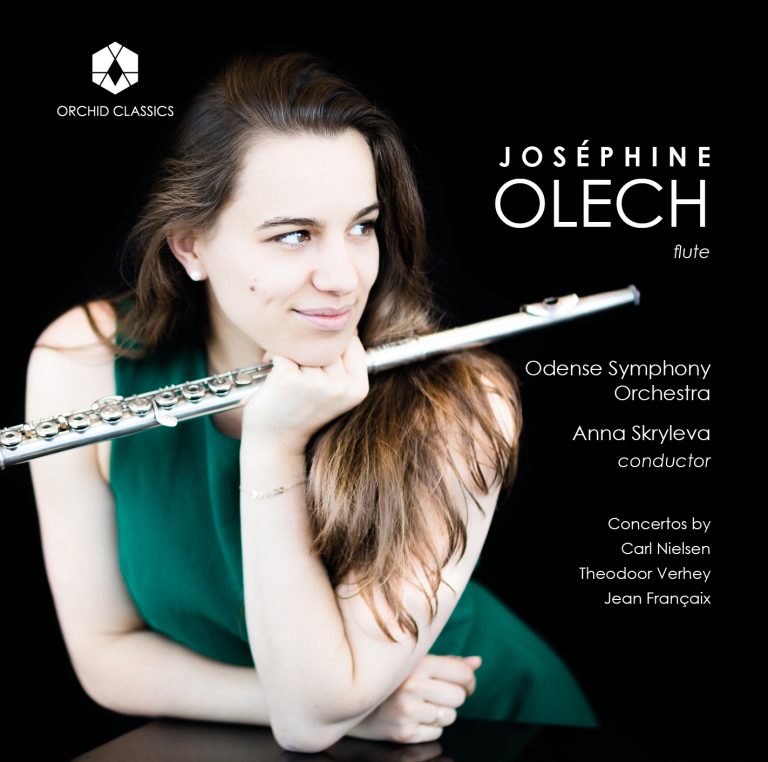Artist Led, Creatively Driven

BADINERIE
Julien Beaudiment, flute
Marie-Pierre Langlamet, harp
Release Date: July 19th
ORC100314
BADINERIE
Francis Poulenc (1899-1963)
Sonata for Flute and Piano, FP 164
1. I Allegretto malinconico
2. II Cantilena: Assez lent
3. III Presto giocoso
Wolfgang Amadeus Mozart (1756-1791)
4. Adagio from Flute Quartet in D major, KV 285
Johann Sebastian Bach (1685-1750)
5. Badinerie from Orchestral Suite No.2 in B minor, BWV 1067
Christoph Willibald Gluck (1714-1787)
6. Dance of the Blessed Spirits from Orpheus and Eurydice
Béla Bartók (1881-1945)
Suite Paysanne Hongroise
7. Rubato
8. Andante poco sostenuto
9. Poco rubato
10. Andante
11. Allegro
12. Vielles danses
13. Allegretto
14. Allegretto
15. L’istesso Tempo
16. Assai moderato
17. Allegretto
18. Poco più vivo
19. Allegro
20. Allegro
Arranged by Paul Arma
Camille Saint-Saëns (1835-1921)
21. Danse macabre
Arranged by Giuseppe Gariboldi
Claude Debussy (1862-1918)
22. Beau soir
Nicolai Rimsky-Korsakov (1844-1908)
23. Hindu lied
Manuel de Falla (1876-1946)
24. Nana
25. Polo
26. Asturiana
Astor Piazzolla (1921-1992)
L’Histoire du tango
27. Bordel 1900
28. Café 1930
29. Nightclub 1960
30. Concert d’aujourd’hui
Arranged by Fabrice Pierre
Julien Beaudiment, flute
Marie-Pierre Langlamet, harp
The fantastic thing about working with a harpist is that musical life is full of unpredictability. Nothing is written in stone, perhaps due to ‘pedal syndrome’, or the horrible difficulty that this instrument demands. What you organize on a Monday won’t be the same on a Tuesday. Playing the flute is in comparison as simple as organising a strike in France…
For many years, Marie-Pierre and I have been thinking about making a CD. Every time, after every concert, there was always one of us saying “We have to make an album”. Then one day, annoyed by this mantra which never ended in a recording, I said: “Okay, this year”. And I was really serious – I had to decide that my life would now be surrounded by pedals, broken strings, programme changes, copies with tape at the wrong place, or at the right place but for the wrong piece of music. My life would never be the same for all those reasons, but most of all for one: playing and recording with the best harpist in the world.
We have already toured for at least 15 years. I first met Marie-Pierre in Beijing, when I was asked to play a concerto with the Beijing Opera House Orchestra and Lawrence Foster conducting. My love for the flute and harp concerto is so deep, and I always dreamed to play this concerto with M.P. We met, played, and it was musical love at first sight. Mozart became a religion for her, and we decided to record the adagio from the flute quartet in D. In that piece, M.P uses a kind of plastic wire that goes between the strings of the harp, which gives the pizzicato effect of a string trio. (I of course forgot to explain to you that playing with a harpist also demands a versatility of handicraft and DIY…)
One day, not so long ago, we had to play in the beautiful Cimiez Cloister in Nice, where M.P is from. Every time we play a recital we always try to include new pieces to make the programme challenging for both of us, and to avoid falling into the traditional flute and harp recital with the same pieces of music. And this is when my partner in crime decided to add to the programme the famous flute and piano sonata by Poulenc. I was kind of surprised, suspicious that the piece could work for the harp. In my life, I have seen my parents working a lot, I have seen my mother working late as a nurse, my father working late as a psychiatrist trying to save the population of our home town, I have seen builders sweating while building houses, I have seen people trying hard to enjoy the poisonous British marmite, but I have never seen someone working as much as she did to be able to play this music on the harp. As for today, I want to pay a tribute to my partner for her amazing work and playing in this sonata. Premiered in 1957 by the world-famous flautist Jean-Pierre Rampal, this piece of music has ever since been a ‘must play’ for all flautists around the world. The French newspaper Le Figaro said at the premiere that ‘The music burst forth from the heart, without formality, and ‘sang’, in every sense’. Someone else said that the sonata was ‘the best of Poulenc, and even a little better’.
From Berlin to Ljubljana, via Istanbul, we have played all kinds of music and arrangements. It was actually very hard to make a selection for this album, between the huge possibilities that we had with these 2 instruments. Mozart was the first to understand the beauty of this pairing when he composed the flute and harp concerto. Even if the flute and the harp sound completely different, it is this opposition which gives such richness to the combination. The lyricism and liquid sound of the flute needs the sublime string sound of the harp and its harmonic texture. It is easy to understand this concept in the three popular songs by De Falla, where Nana sings an Andalusian lullaby, where Asturiana suddenly makes time slower, or where Pollo describes the text: I have a pain in my heart, that I will not tell anyone! Love be damned, and who taught me to understand it! What a challenge to express this with one flute and a harp!
The Hindu lied by Rimsky-Korsakov brings us to the beauty of India, while Bartok takes us to the roots of Hungarian folk music. The challenge of this work was to recreate, in 14 very short pieces, the mood and character of traditional Hungarian folk music. The flute has to sound at the same time dreamy, country, even muddy, as the harp has to respond harmonically and rhythmically very fast (a lot of pedals indeed…)
This album could be considered as a travel postcard, but if I also look back at those 15 years of music and friendship, I realize that we did actually play many recitals in the south of France as well. Nice is the home of sun but also the home of the most important French music academy in the summer. Marie-Pierre and I have taught there every summer since at least 20 years ago, and destiny has made us play there often. There can’t be any flute and harp recital without French music. Debussy has a special link with Nice, this is where he composed his famous Syrinx for solo flute. In Beau soir the music and lyrics create a beautiful serenity, with the words:
When at sunset the rivers are pink
And a warm breeze ripples the fields of wheat, All things seem to advise content And rise toward the troubled heart;
Advise us to savour the gift of life, While we are young and the evening fair, For our life slips by, as that river does: It to the sea – we to the tomb.
The Saint-Saëns Danse Macabre in this album is a short version arranged by the flautist and composer Giuseppe Gariboldi for flute and piano. We wanted to propose this great and clever version by the Italian maestro to add some darkness and humour. We tried to play as if on Halloween, creating dark colours and articulations.
The very famous Histoire du tango by Piazzolla is a musical history book which explains the transformation of the Tango through four different periods of time. M.P uses here a special sound which has to match the original score written for the guitar. You will tell me, well, if you want to match the guitar, why don’t you play it with a guitar? I agree, but the harp gives another texture, sometimes deeper than the guitar and even more powerful. I tried to add some effects also, which gives to the piece some new perspectives such as airy sound, air spiccato, or the brassy articulation in the last movement.
The badinerie ends with the B minor suite for flute by Bach. A crazy virtuosic moment for the flute that everybody knows (not least from mobile phone ring tones). A Badinerie means in French something that you do instinctively, without taking it too seriously, something which is epicurean and gives pleasure. We thought that this could be the title of our album, full of discoveries, surprises, challenges, depth, but most of all, a tribute to this duet which makes music alive and gives us happiness, which we hope you will feel as well. We thank you for listening to us.
Julien Beaudiment
Julien Beaudiment
Flute
Julien Beaudiment is considered as one of France’s leading flautists. After holding the position of principal flute of the prestigious Los Angeles Philharmonic under Gustavo Dudamel, Julien Beaudiment is today principal flute of the Orchestre de l’Opera National de Lyon and professor at the Conservatoire National Supérieur de Musique de Lyon. He has also held the same position with the BBC National Orchestra of Wales.
After his studies at the Guildhall School of Music and Drama in London with Paul Edmund-Davies, Julien entered the Conservatoire National Supérieur de music de Paris, where he won the first prize of flute in the class of Sophie Cherrier.
Julien plays now in the most beautiful halls in the world as a soloist and within the Berliner Philharmoniker, the Orchestra Simon Bolivar of Venezuela, the Estonian Festival, the London Symphony Orchestra, the London Philharmonic Orchestra, the Philharmonia, the Scottish Chamber Orchestra, the Academy of St. Martin in the Fields, the Hallé Orchestra, the Beijing Opera Orchestra, the Orchestre de Paris, the Orchestre de l’Opéra National de Paris and the NDR Orchestra in Hamburg. He performs under the direction of Sir Simon Rattle, Sir Antonio Pappano, Gustavo Dudamel, Esa Pekka Salonen, Sir Colin Davis, Paavo Järvi, Christoph Eschenbach, Michael Tilson Thomas, Vladimir Jurovski, Kirill Petrenko, Robin Ticciati, Charles Dutoit, Semyon Bychkov, Christian Zacharias, James Conlon, Sir Roger Norrington, William Christie, Ivan Fischer, and alongside musicians such as Joshua Bell, Murray Perahia and Itzhak Perlman, and the Hollywood star John Williams.
Marie-Pierre Langlamet
Harp
Marie-Pierre Langlamet, born in 1967, completed her musical studies at the Conservatory of Nice under Elizabeth Fontan-Binoche. At just 17, she secured the position of principal harpist with the Nice Orchestra but decided to deepen her education in the United States at the Curtis Institute of Music in Philadelphia after a year. Since 1993, Marie-Pierre Langlamet has been the principal harpist of the Berlin Philharmonic Orchestra (under the direction of Simon Rattle), after holding the same position at the Metropolitan Opera Orchestra in New York from 1988 to 1993 (under James Levine).
Concurrently, Marie-Pierre Langlamet continues her career as a soloist and chamber musician. She has performed with the Berlin Philharmonic Orchestra, the Rundfunk Sinfonie Orchester Berlin (RSO), the Israel Philharmonic Orchestra, the Orchestre de la Suisse Romande, the Swiss Radio Orchestra, the Orchestre National de Lille, among others. She has appeared as a soloist alongside Claudio Abbado, Simon Rattle, Marek Janowski, Donald Runnicles, Hugh Wolf, François-Xavier Roth, Ilan Volkov, Horst Stein, in prestigious venues such as the Berlin Philharmonie, Suntory Hall in Tokyo, Concertgebouw in Amsterdam, Royal Albert Hall in London, Avery Fisher Hall in New York, Salle Pleyel in Paris, and KKL in Lucerne.









